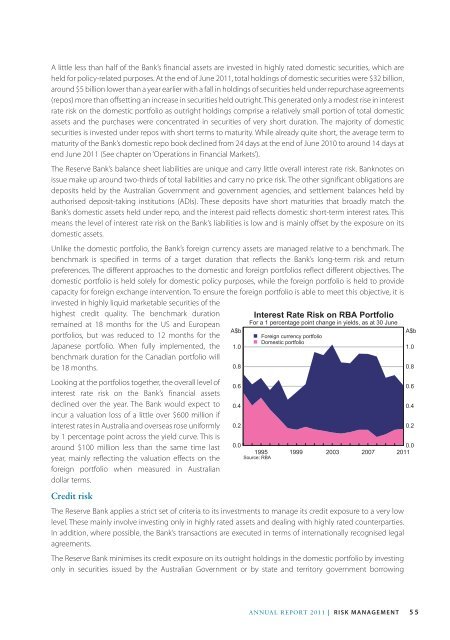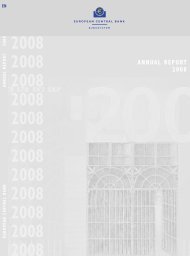Reserve Bank of Australia Annual Report 2011
Reserve Bank of Australia Annual Report 2011
Reserve Bank of Australia Annual Report 2011
Create successful ePaper yourself
Turn your PDF publications into a flip-book with our unique Google optimized e-Paper software.
A little less than half <strong>of</strong> the <strong>Bank</strong>’s financial assets are invested in highly rated domestic securities, which are<br />
held for policy-related purposes. At the end <strong>of</strong> June <strong>2011</strong>, total holdings <strong>of</strong> domestic securities were $32 billion,<br />
around $5 billion lower than a year earlier with a fall in holdings <strong>of</strong> securities held under repurchase agreements<br />
(repos) more than <strong>of</strong>fsetting an increase in securities held outright. This generated only a modest rise in interest<br />
rate risk on the domestic portfolio as outright holdings comprise a relatively small portion <strong>of</strong> total domestic<br />
assets and the purchases were concentrated in securities <strong>of</strong> very short duration. The majority <strong>of</strong> domestic<br />
securities is invested under repos with short terms to maturity. While already quite short, the average term to<br />
maturity <strong>of</strong> the <strong>Bank</strong>’s domestic repo book declined from 24 days at the end <strong>of</strong> June 2010 to around 14 days at<br />
end June <strong>2011</strong> (See chapter on ‘Operations in Financial Markets’).<br />
The <strong>Reserve</strong> <strong>Bank</strong>’s balance sheet liabilities are unique and carry little overall interest rate risk. <strong>Bank</strong>notes on<br />
issue make up around two-thirds <strong>of</strong> total liabilities and carry no price risk. The other significant obligations are<br />
deposits held by the <strong>Australia</strong>n Government and government agencies, and settlement balances held by<br />
authorised deposit-taking institutions (ADIs). These deposits have short maturities that broadly match the<br />
<strong>Bank</strong>’s domestic assets held under repo, and the interest paid reflects domestic short-term interest rates. This<br />
means the level <strong>of</strong> interest rate risk on the <strong>Bank</strong>’s liabilities is low and is mainly <strong>of</strong>fset by the exposure on its<br />
domestic assets.<br />
Unlike the domestic portfolio, the <strong>Bank</strong>’s foreign currency assets are managed relative to a benchmark. The<br />
benchmark is specified in terms <strong>of</strong> a target duration that reflects the <strong>Bank</strong>’s long-term risk and return<br />
preferences. The different approaches to the domestic and foreign portfolios reflect different objectives. The<br />
domestic portfolio is held solely for domestic policy purposes, while the foreign portfolio is held to provide<br />
capacity for foreign exchange intervention. To ensure the foreign portfolio is able to meet this objective, it is<br />
invested in highly liquid marketable securities <strong>of</strong> the<br />
highest credit quality. The benchmark duration<br />
remained at 18 months for the US and European<br />
portfolios, but was reduced to 12 months for the<br />
Japanese portfolio. When fully implemented, the<br />
benchmark duration for the Canadian portfolio will<br />
be 18 months.<br />
Looking at the portfolios together, the overall level <strong>of</strong><br />
interest rate risk on the <strong>Bank</strong>’s financial assets<br />
declined over the year. The <strong>Bank</strong> would expect to<br />
incur a valuation loss <strong>of</strong> a little over $600 million if<br />
interest rates in <strong>Australia</strong> and overseas rose uniformly<br />
by 1 percentage point across the yield curve. This is<br />
around $100 million less than the same time last<br />
year, mainly reflecting the valuation effects on the<br />
foreign portfolio when measured in <strong>Australia</strong>n<br />
dollar terms.<br />
Credit risk<br />
The <strong>Reserve</strong> <strong>Bank</strong> applies a strict set <strong>of</strong> criteria to its investments to manage its credit exposure to a very low<br />
level. These mainly involve investing only in highly rated assets and dealing with highly rated counterparties.<br />
In addition, where possible, the <strong>Bank</strong>’s transactions are executed in terms <strong>of</strong> internationally recognised legal<br />
agreements.<br />
The <strong>Reserve</strong> <strong>Bank</strong> minimises its credit exposure on its outright holdings in the domestic portfolio by investing<br />
only in securities issued by the <strong>Australia</strong>n Government or by state and territory government borrowing<br />
A$b<br />
1.0<br />
0.8<br />
0.6<br />
0.4<br />
0.2<br />
Interest Rate Risk on RBA Portfolio<br />
For a 1 percentage point change in yields, as at 30 June<br />
• Foreign currency portfolio<br />
• Domestic portfolio<br />
0.0<br />
1995<br />
Source: RBA<br />
1999<br />
2003<br />
2007<br />
A$b<br />
1.0<br />
0.8<br />
0.6<br />
0.4<br />
0.2<br />
0.0<br />
<strong>2011</strong><br />
ANNUAL REPORT <strong>2011</strong> | Risk Management<br />
55





![KNOW YOUR NEW GIBRALTAR BANKNOTES - [Home] bThe/b](https://img.yumpu.com/50890985/1/184x260/know-your-new-gibraltar-banknotes-home-bthe-b.jpg?quality=85)
![PAPUA NEW GUINEA - [Home] - Polymer Bank Notes of the World](https://img.yumpu.com/49758743/1/190x143/papua-new-guinea-home-polymer-bank-notes-of-the-world.jpg?quality=85)










